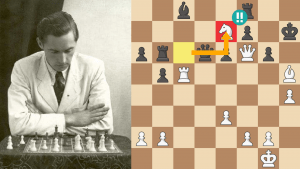
Can You Solve These Brilliancy Prize Chess Tactics?
Once again I offer puzzles full of tactics or sharp attacks. And, as in the previous article, all of them won brilliancy prizes.
I’m offering small bios so you know who these players are, and I often give lots of analysis and prose, which you can see by clicking the question mark at the bottom of the board.
So, wake up, put on your magic beanie cap, and let’s get ready to RUMMMMBLE!!!!
PUZZLE ONE
Arturo Reggio (born 1863, died 1917) was known as Italy's best player.
Jacques Mieses (born 1865, died 1954 at the age of 88) was born in Germany but became a British citizen after World War II. He was a grandmaster and was also quite a good chess writer. He was always physically fit but failed to hit 90, dying a few days before his 89th birthday. Mieses was one of those guys who spat at positional chess, preferring a kill-or-die mentality.
PUZZLE TWO
Dawid Janowski (born 1868, died 1927 of tuberculosis) was a Polish master who was one of the strongest players in the world. He was an attacking player, and he felt that he could beat anyone. Indeed, he proved it with wins over Capablanca, Emanuel Lasker, Steinitz, Chigorin, Blackburne, Tarrasch, Rubinstein, Marshall, etc. He was also extremely stubborn. Frank Marshall wrote: “Janowski could follow the wrong path with greater determination than any man I ever met!”
Siegbert Tarrasch (born 1862, died 1934), who was a medical doctor, was thought to be the best player in the world in the early 1890s. However, he ran into a roadblock named Emanuel Lasker. A powerful positional player, Tarrasch took Steinitz’s ideas and smoothed them out, thereby making these easier for the masses.

Janowski via Wikipedia.
PUZZLE THREE
Gersz Salwe (born 1862, died 1920) was a grandmaster, but many modern chess fans don’t know who he was. However, he had quite a few successes in matches and tournaments. For example: tying a match against Rubinstein five wins, five losses, no draws. He beat Mieses in a match 2-1 (no draws). He came second and third in Warsaw 1911 (Rubinstein came in first), and did well in many other tournaments.
PUZZLE FOUR
Rudolf Swiderski (born 1878, died 1909) was a German master who had some pretty good results. However, his death was rather odd: Finding himself in trouble with the law, and convicted of perjury in a trial, the idea that he was going to face a scandal was too much for him. He committed suicide by by poisoning himself and then shooting himself in the head.
Eugene Znosko-Borovsky (born 1884, died 1954) was a very strong Russian master (he won games against Capablanca, Rubinstein, Euwe, Bogoljubov, etc.), a chess teacher, and a very good chess writer. On top of that, he was a music and drama critic. Whenever I see his name I remember buying a book when I was 14 years old (by Znosko-Borovsky) titled The Art of Chess Combination. My tactics were horrible, but after reading his book for two months, I played in a club tournament and wiped out a 1900 player by using a couple of tactical patterns.
Eugene Znosko-Borovsky via Wikipedia.
PUZZLE FIVE
Jorgen Moller (born 1873, died 1944), sometimes spelled Moeller, was a lawyer and the strongest Danish player of his time. However, he wasn’t in the class of the big guys. He created the following line in the Giuoco Piano: 1.e4 e5 2.Nf3 Nc6 3.Bc4 Bc5 4.c3 Nf6 5.d4 exd4 6.cxd4 Bb4+ 7.Nc3 Nxe4 8.0-0 Bxc3 9.d5, which is called the “Moller Attack.” He also came up with a sharp setup in the Ruy Lopez, now called the “Moller Defense”: 1.e4 e5 2.Nf3 Nc6 3.Bb5 a6 4.Ba4 Nf6 5.O-O Bc5.
Stepping back to our puzzle, I must admit that it’s my favorite of this batch. I already mentioned (in puzzle one) that Mieses had a kill-or-die mentality, and this shows just how vicious his style was. What I really like in this game is the apparently calm position, which seems good for Black. Black is two pawns up, and all seems well for the Danish player. Of course, that’s not the case at all! When you’re done, please look at the copious notes, which show a stream of tactical patterns.
PUZZLE SIX
Julius Perlis (born 1880, died 1913) was a Polish player who took up shop in Austria. He was extremely strong, and had excellent results in the many tournaments he played in. Keep in mind that players like Chigorin, Mieses, Schlechter, Rubinstein, Emanuel Lasker, Reti, etc. were his competition. Sadly, he died young from a mountaineering accident in the Alps.






